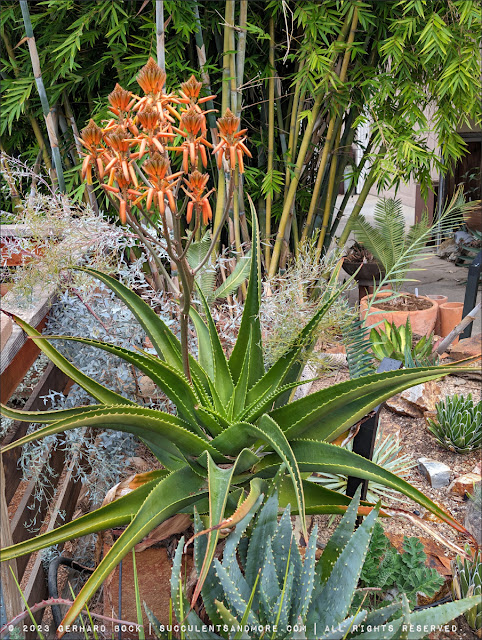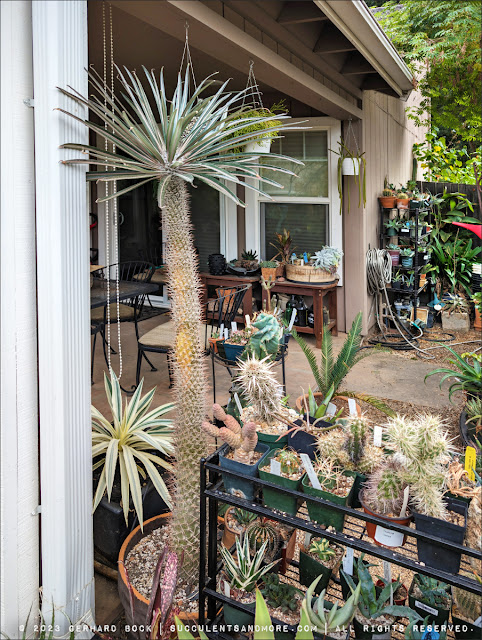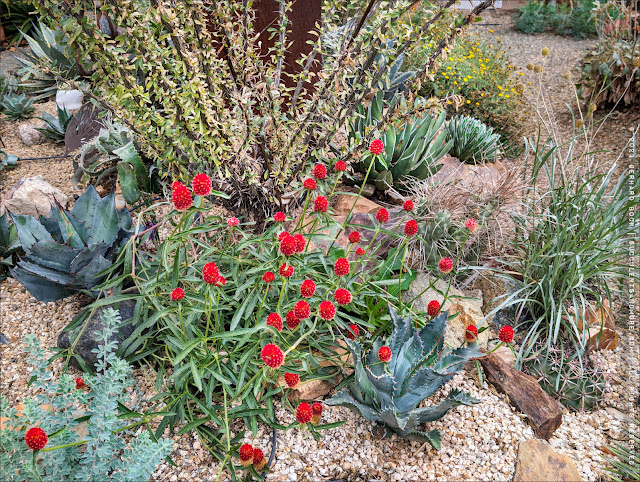Early November garden update
When I’m away from home, I constantly wonder what’s going on in the garden. And when I get back, one of the first things I do is to determine what might have changed since during my absence. I returned from Germany on Saturday night, and on Sunday morning I checked out the garden even before I had coffee. Most of what I found was as expected, but there were some surprises, too. Let’s take a look.
Most of the leaves on our Agave ‘Blue Glow’ are growing in an orderly fashion, but these two are at each other’s throat:
 |
| Agave ‘Blue Glow’ |
A few months ago, I redid the area where our Agave bovicornuta had been. As you may remember, I removed it after it had flowered and died, reclaiming a nice-sized piece of real estate. To the right of this area is the last remaining bamboo in our garden, the clumping Bambusa chungii ‘Barbellata’. Imagine my surprise when I saw this:
A new bamboo culm emerging from under the newly planted Agave bovicornuta ‘Holstein’, a variegated variety of the cow horn agave!
That, of course, won’t do.
In fact, there are a couple of dozen newly emerging culms. Some are in the right place, others – like that one above and the one below – are not. Fortunately, new culms are very easy to snap off; most of the time, a good kick is all it takes. Of course there’s no guarantee that next year’s culms won’t appear in the same place, but we’ll cross that bridge when we come to it. As I mentioned earlier, this is our last remaining bamboo, and I don’t want to remove it because it provides vital protection for the tender plants in the bed next to the front door – and it looks great.
On a more positive note, my largest and oldest Aloe lukeana is flowering for the first time (my smaller A. lukeana is also pushing an inflorescence):
 |
| Aloe lukeana |
The flowers are spectacular. The wait has definitely been worth it.
 |
| Aloe lukeana |
Note: Aloe lukeana is native to northeastern Uganda. It was described in 2015 by humanitarian aid worker and botanist Tom Cole. He named it after his late brother Luke, who had died in a car accident in Uganda in 2009. Tom wrote an evocative article about his discovery of Aloe lukeana for the CSSA's Cactus and Succulent Journal (2015 Volume 87 Number 4); you can read it here.
Aloe suprafoliata isn’t far behind:
 |
| Ghostly blue Aloe suprafoliata |
And Aloe ‘Moonglow’ is working on inflorescences, too:
 |
| Aloe ‘Moonglow’, one of three in the sidewalk bed |
Two mangaves are flowering in the front yard. The inflorescence of Mangave ‘Night Owl’ is leaning too far over the sidewalk...
 |
| Mangave ‘Night Owl’ in flower |
 |
| Mangave ‘Night Owl’ in flower |
...so I cut it off.
The other flowering mangave is Mangave ‘Sponge Paint’. Fortunately, its inflorescence isn’t in the way:
 |
| Mangave ‘Sponge Paint’ in flower |
A few flowers of a different kind:
 |
| Salvia ‘Marine Blue’ with stunning blue flowers |
Flowers are nice, but so are leaves:
 |
| Giant sea squill (Drimia maritima) is pushing leaves. They’ll persist until late spring, then die, giving way to flowers in late summer. |
 |
| Abutilon palmeri, a Southern California native, has exploded this year, producing hundreds upon hundreds of orange flowers. It’ll get a radical trim in late winter. |
The citrus season is getting closer:
 |
| The Meyer lemon in the front yard has good crop this year, and it’s flowering again |
 |
| Valencia oranges in the backyard |
Pachypodium geayi has enjoyed a sunny spot all summer but it’ll spend the winter on the porch, up against the house, since it’s too tender to be left out in the open:
 |
| Pachypodium geayi |
Tylecodon is a genus of winter-growing succulents from southern Africa. The name is an anagram of Cotyledon, the genus they belonged to until 1978. I have several tylecodons, and they’ve done well over the years, requiring no frost or rain protection:
 |
| Tylecodon × dinteri, a natural hybrid of Tylecodon wallichii and Tylecodon paniculatus |
 |
| The parents of T. × dinteri above: Tylecodon wallichii (top) and Tylecodon paniculatus (bottom) |
 |
| Many winter-growing South African bulbs are pushing leaves. This is Lachenalia aloides var. quadricolor. |
 |
| Massonia pustulata, a bulb from the Western Cape of South Africa |
 |
| Veltheimia capensis seedlings, year 3. I’ll put them in individual pots in late winter. |
 |
| Mature Veltheimia capensis along the sidewalk. Soon they’ll look like this. |
Arguably the biggest thing that happened during my absence was this mature Queen Victoria agave (Agave victoriae-reginae) showing up at the foot of our driveway:
It turns out it was a gift from a neighbor, who had owned it for 20+ years. She wasn’t able to take care of it any longer and thought it would be a good addition to our garden. I think it’s still in its original nursery pot!
It’ll go in the redone bed where Agave bovicornuta had been – where the stray bamboo culm appeared while I was gone. I’ll post a photo after I’m done.
© Gerhard Bock, 2023. All rights reserved. To receive all new posts by email, please subscribe here.










Very interesting with great photos. Thanks
ReplyDeleteSo glad you stopped by!
DeleteWOW! What a wonderful neighbor to give you that beautiful v-r. That alone must have been worth getting up early for.
ReplyDeleteMy Drimia are pushing out leaves, too. Only one flower stem this year--what's with that? Maybe the cool May/June.
Excellent flower on the lukeana--I thought mine maybe has the startings of one but it was just an oak leaf between leaves. Maybe next year. Suprafoliata here has stems also in the same stage as yours.
Hopefully the wayward bamboo culms won't set back any of the new residents of that area.
I still can't believe she just gave me that beautiful victoriae-reginae! It's in the ground now, looking very regal.
DeleteIt took my lukeana 5+ years to get to flowering size so don't give up hope. The flowers are worth the wait.
I can’t believe she could even water it. Or maybe she didn’t? Looks like it long since escaped it’s pot.
DeleteHonestly, I don't know how it got watered. Maybe by immersing the whole pot?
DeleteStepping away from the garden for a bit obviously yields lots of surprises, most good. Your neighbour obviously knows you will take good care of her agave. She might start a trend with you adopting plants that people can no longer care for. (Lol). Are the blooming Mangave's monocarpic?
ReplyDeleteI believe most mangaves are monocarpic. 'Night Owl' definitely is. The mother plant is pretty much gone, but there are a couple of pups.
DeleteWell that's a nice gift! Your Mangave ‘Night Owl’ bloom looked quite floriferous.
ReplyDelete'Night Owl' bloomed much too fast, but it looks like there might be a pup or two hatching under the mama plant.
DeleteCool flowers on the lukeana, I'm always looking for one. Gomphrena looks so bright, I have a different colored one and love it as well - it's come on strong later in the year. What a nice gift from your neighbor! Always good to come home.
ReplyDeleteThe Institute for Aloe Studies sells A. lukeana ($14). Go to https://aloestudies.org/store.html and select item 4 from the dropdown.
DeleteThank you!
DeleteWow, I love the flowers on Mangave ‘Night Owl’ ! I wonder if it will live after flowering. I have a very small one but it does not seem happy at the moment! Love all that is going on in your garden!
ReplyDelete'Night Owl' is toast. There was a pup coming out from between the leaves, but I wasn't able to successfully detach it. These axillary offsets tend to be difficult to root.
DeleteWell, at least it had very nice flowers before it was gone!
DeleteNice Post
ReplyDelete